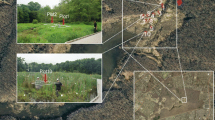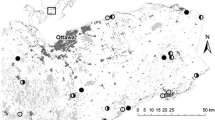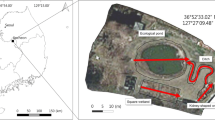Abstract
Urban wetlands can serve to reduce flooding and improve water quality, yet we know little about their plant communities. Our study aims to characterize the vegetation and soil parameters of these important ecosystems, and to compare these features to those of previously sampled natural wetlands in south-central New York. Vegetation and soil characteristics were sampled in eight urban wetlands and compared to six forested wetlands, five scrub-shrub wetlands, and seven emergent wetlands. Urban sites had significantly lower species richness and a higher percent cover of invasives, including Typha x glauca, Phalaris arundinacea, and Lythrum salicaria. However, non-invasive species were also common in urban flora, including Leersia oryzoides, Ludwigia palustris, and Sagittaria latifolia. Urban wetlands had a high percentage of obligate wetland species, and most closely resembled emergent wetlands in their vegetation composition. Soil pH and soil electrical conductivity were significantly higher in urban sites, but potential net N-mineralization rates were significantly lower. Urban wetland vegetation and soil characteristics are different than those in nearby natural wetlands, and our increased knowledge of these urban ecosystems will lead to more successful restoration and creation projects.



Similar content being viewed by others
References
Angold PG (1997) The impact of a road upon adjacent heathland vegetation: Effects on plant species composition. J Appl Ecol 34(2):409–417
Bachand PAM, Horne AJ (2000) Denitrification in constructed free-water surface wetlands: II. Effects of vegetation and temperature. Ecol Eng 14:17–32
Bakker JP, Esselink P, Dijkema KS, van Duin WE, de Jong DJ (2002) Restoration of salt marshes in the Netherlands. Hydrobiologia 478:29–51
Baldwin A (2004) Restoring complex vegetation in urban settings: the case of tidal freshwater marshes. Urban Ecosystems 7:125–137
Chen X, Wang W, Liang H, Liu X, Da L (2014) Dynamics of ruderal species diversity under the rapid urbanization over the past half century in Harbin, Northeast China. Urban Ecosystems 17:455–472
Chu S, Molano-Flores B (2013) Impacts of agricultural to urban land-use change on floristic quality assessment indicators in northeastern Illinois wetlands. Urban Ecosystems 16:235–246
DeBerry DA, Perry JE (2015) Using the floristic quality concept to assess created and natural wetlands: ecological and management implications. Ecol Indic 53:247–257
Doherty JM, Zedler JB (2014) Dominant graminoids support restoration of productivity but not diversity in urban wetlands. Ecol Eng 65:101–111
Ehrenfeld JG (2000) Evaluating wetlands within an urban context. Urban Ecosystems 4:69–85
Ehrenfeld JG (2005) Vegetation of forested wetlands in urban and suburban landscapes in New Jersey. J Torrey Bot Soc 132(2):262–279
Ewing K (1996) Tolerance of four wetland plant species to flooding and sediment deposition. Environ Exp Bot 36(2):131–146
Findlay CS, Houlahan J (1997) Anthropogenic correlates of species richness in southeastern Ontario wetlands. Conserv Biol 11(4):1000–1009
Galatowitsch SM, Anderson NO, Asher PD (1999) Invasiveness in wetland plants in temperate North America. Wetlands 19(4):733–755
Gale PM, Reddy KR, Graetz DA (1993) Denitrification potential of soils from constructed and natural wetlands. Ecol Eng 2:119–130
Gleason RA, Cronquist A (1991) Manual of vascular plants of northeastern United States and adjacent Canada, New York Botanical Garden. Bronx, NY
Green RH (1979) Sampling design and statistical methods for environmental biologists. J. Wiley and Sons, New York, New York USA
Green EK, Galatowitsch SM (2002) Effects of Phalaris arundinacea and nitrate-N addition on the establishment of wetland plant communities. J Appl Ecol 39:134–144
Hall S, Zedler J (2010) Constraints on sedge meadow self-restoration in urban wetlands. Restor Ecol 18(5):671–680
Harrison MD, Groffman PM, Mayer PM, Kaushal SS, Newcomer TA (2011) Denitrification in alluvial wetlands in an urban landscape. J Environ Qual 40(2):634–646
Hettiarachchi M, Morrison TH, McAlpine C (2015) Forty-three years of Ramsar and urban wetlands. Glob Environ Chang 32:57–66
Kaye JP, Groffman PM, Grimm NB, Baker LA (2006) A distinct urban biogeochemistry. TRENDS Ecol Evol 21(4):192–199
Kruskal WH, Wallis WA (1952) Use of ranks in one-criterion analysis of variance. J Am Stat Assoc 47:583–621
Lichvar RW (2014) The National Wetland Plant List: 2014 wetland ratings. Phytoneuron 2014-41:1–42
Lopez RD, Fennessy SM (2002) Testing the floristic quality assessment index as an indicator of wetland condition. Ecol Appl 12(2):487–497
Magee TK, Ernst TL, Kentula ME, Dwire KA (1999) Floristic comparison of freshwater wetlands in an urbanizing environment. Wetlands 19(3):517–534
Malaviya P, Singh A (2012) Constructed wetlands for management of urban stormwater runoff. Crit Rev Environ Sci Technol 42:2153–2214
McCune B, Mefford MJ (1999) PC-ORD. Multivariate Analysis of Ecological Data, Version 4. MjM Software Design, Gleneden Beach, Oregon, USA
Middleton B (1999) Wetland restoration, flood pulsing, and disturbance dynamics. John Wiley and Sons, New York
Miller SJ, Wardrop DH (2006) Adapting the floristic quality assessment index to indicate anthropogenic disturbance in Central Pennsylvania wetlands. Ecol Indic 6:313–326
Mitsch WJ, Gosselink JG (2000) The value of wetlands: importance of scale and landscape setting. Ecol Econ 35:25–33
Moscrip AL, Montgomery DR (1997) Urbanization, flood frequency, and salmon abundance in Puget lowland streams. J Am Water Resour Assoc 33:1289–1297
Mueller-Dombois D, Ellenberg H (1974) Aims and methods of vegetation ecology. Wiley, New York
Nairn RW, Mitsch WJ (2000) Phosphorus removal in created wetland ponds receiving river overflow. Ecol Eng 14:107–126
Noble A, Hassall C (2015) Poor ecological quality of urban ponds in northern England: causes and consequences. Urban Ecosystems 18:649–662
Penn State Riparia Floristic Quality Assessment Calculator. (2016) The Mid-Atlantic Wetland Work Group. http://apps.cei.psu.edu/fqacalc/. Accessed 2 Nov 2015
Qian H, Ricklefs RE (2006) The role of exotic species in homogenizing the North American flora. Ecol Lett 9:1293–1298
Richburg JA, Patterson WA III, Lowenstein F (2001) Effects of road salt and Phragmites australis invasion on the vegetation of a western Massachusetts calcareous lake-basin fen. Wetlands 21(2):247–255
Rooney TP, Rogers DA (2002) The modified floristic quality index. Nat Areas J 22(4):340–344
Savard JPL, Clergeau P, Mennechez G (2000) Biodiversity concepts and urban ecosystems. Landsc Urban Plan 48:131–142
Stander EK, Ehrenfeld JG (2009a) Rapid assessment of urban wetlands: do hydrogeomorphic classification and reference criteria work? Environ Manag 43:725–742
Stander EK, Ehrenfeld JG (2009b) Rapid assessment of urban wetlands: functional assessment model development and evaluation. Wetlands 29(1):261–276
Swink F, Wilhelm GS (1979) Plants of the Chicago Region, third ed., revised and expanded edition with keys. The Morton Arboretum, Lisle, IL
Swink F, Wilhelm GS (1994) Plants of the Chicago region, fourth edn. Indiana Academy of Science, Indianapolis, IN, USA
Taylor BW, Irwin RE (2004) Linking economic activities to the distribution of exotic plants. Proc Natl Acad Sci U S A 101:17725–17730
Tiner RW (2005) In search of swampland: a wetland sourcebook and field guide, 2nd edn. Rutgers University Press, New Brunswick, NJ, USA and London
United States Department of Agriculture, National Resources Conservation Service (2012) The PLANTS database for the northeast region. National Plant Data Team, Greensboro, NC http://plantsusdagov. Accessed 2 Nov 2015
Vink J, Francis J, Anantsuksomsri S, Tontisirin N, Plambeck J (2013) Broome County profile: a collection of recent demographic, social, economic and agricultural data. Cornell Cooperative Extension, https://pad.human.cornell.edu/profiles/Broome.pdf
Weldy T, Werier D, Nelson A (2015) New York Flora Atlas. [S. M. Landry and K. N. Campbell (original application development), USF Water Institute. University of South Florida]. New York Flora Association, Albany, New York
Wetzel PR, van der Valk AG (1998) Effects of nutrient and soil moisture on competition between Carex stricta, Phalaris arundinacea, and Typha latifolia. Plant Ecol 138:179–190
Wilcox DA, Apfelbaum SI, Hiebert RD (1985) Cattail invasion of sedge meadows following hydrologic disturbance in the Cowles bog wetland complex, Indiana dunes National Lakeshore. Wetlands 4:115–128
Wilcox DA, Kowalski KP, Hoare H, Carlson ML, Morgan H (2008) Cattail invasion of sedge/grass meadows and regulation of Lake Ontario water levels: photointerpretation analysis of sixteen wetlands over five decades. J Great Lakes Res 34:301–323
Wilson MJ, Forrest AS, Bayley SB (2013) Floristic quality assessment for marshes in Alberta’s northern prairie and boreal regions. Aquat Ecosyst Health Manag 16(3):288–299
Woodcock TS, Monaghan MC, Alexander KE (2010) Ecosystem characteristics and summer secondary production in stormwater ponds and reference wetlands. Wetlands 30:461–474
Zedler JB (2000) Progress in wetland restoration ecology. TRENDS Ecol Evol 15(10):402–407
Zedler JB (2005) Ecological restoration: guidance from theory. San Francisco Estuary and Watershed Science 3(2): Art.4
Zedler JB, Kercher S (2004) Causes and consequences of invasive plants in wetlands: opportunities, opportunists, and outcomes. Crit Rev Plant Sci 28:431–452
Zhu W, Ehrenfeld J (1999) Nitrogen mineralization and nitrification in suburban and undeveloped Atlantic white cedar wetlands. J Environ Qual 28(2):523–529
Acknowledgments
We thank Kate Foley, Meaghan Petix, and Sarah Lister for their assistance in the field and lab, as well as Dr. Julian Shepherd and Dr. Mark Blumler for assistance in plant identification. We also thank Stephanie Craig and two anonymous reviewers for their comments on the manuscript. This study was partially supported by a USEPA Region 2 grant to the Upper Susquehanna Coalition Wetland Program subcontracted to Binghamton University and a Wallace Research Foundation grant to Binghamton University.
Author information
Authors and Affiliations
Corresponding author
Rights and permissions
About this article
Cite this article
Larson, M.A., Heintzman, R.L., Titus, J.E. et al. Urban Wetland Characterization in South-Central New York State. Wetlands 36, 821–829 (2016). https://doi.org/10.1007/s13157-016-0789-9
Received:
Accepted:
Published:
Issue Date:
DOI: https://doi.org/10.1007/s13157-016-0789-9




